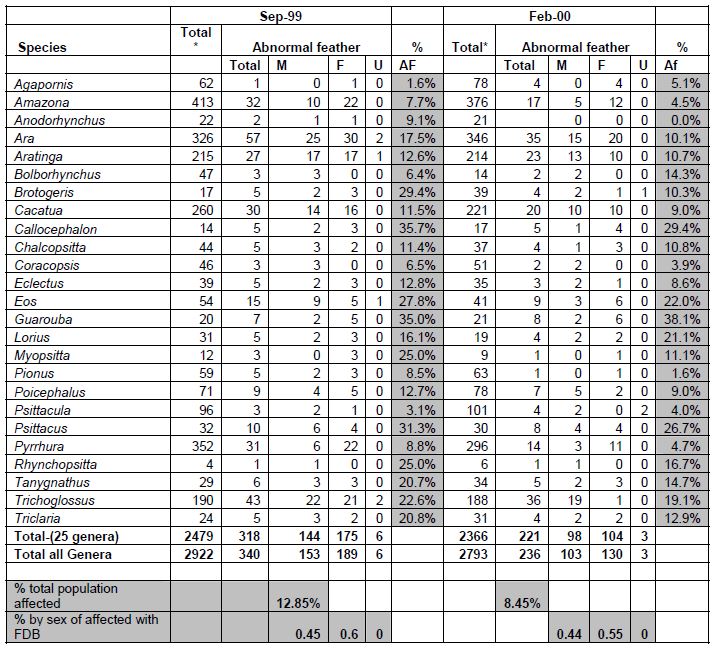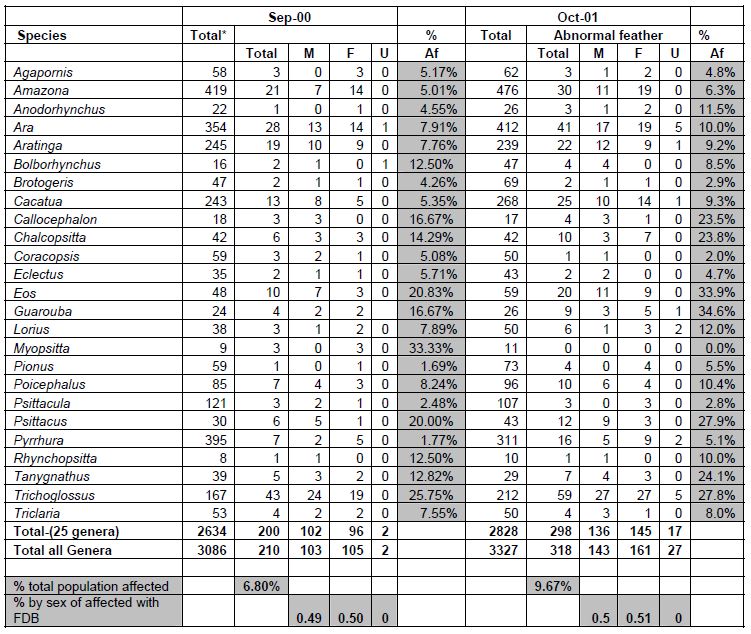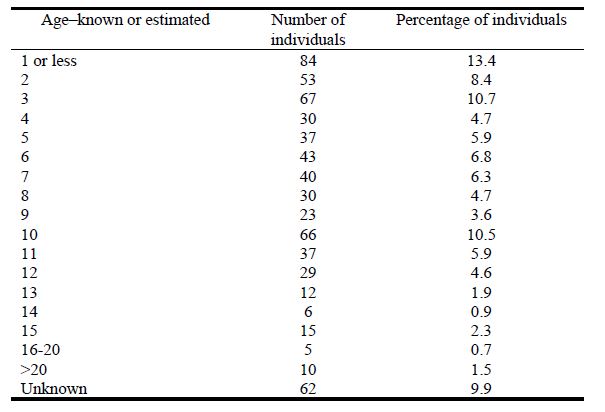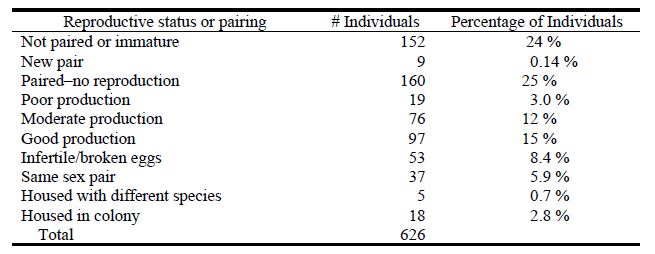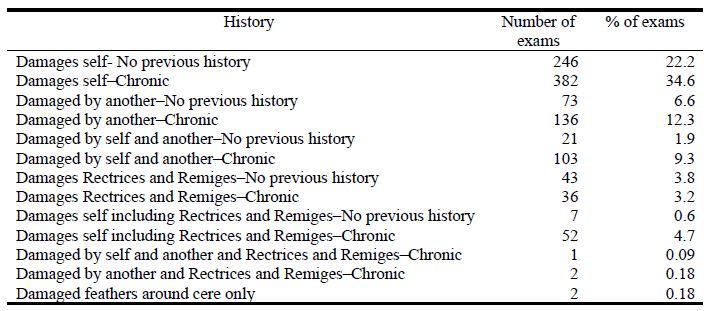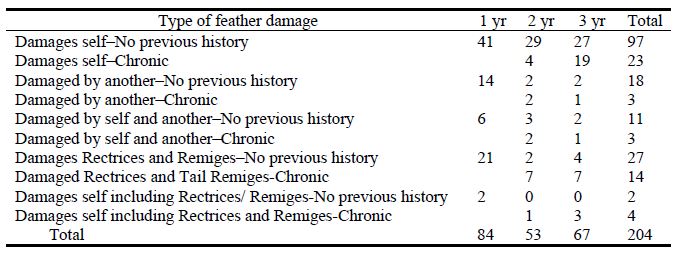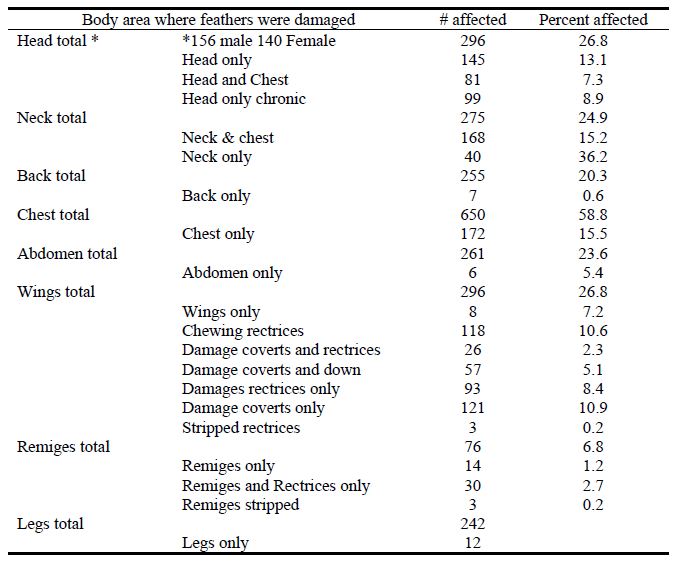Susan L. Clubb, DVM, Dipl ABVP (Avian), Nicola Elmo, Marcellus Buerkle Dr. med. Vet.,
Lorenzo Crosta, Dr. med. Vet., and Frank Enders, Dr. med. Vet.
Session #695
Affiliation: From The Rainforest Clinic for Birds & Exotics, PO Box 508, Loxahatchee, FL 33470, USA (Clubb), Loro Parque, Puerto de la Cruz, Tenerife, Spain (Buerkle, Crosta), and University of Leipzig, Leipzig, Germany (Enders).
Abstract: Feather damaging behavior (FDB) is a common and complex problem associated with the maintenance of psittacine birds in captivity. It is one of the most frequent reasons for presentation of pet birds to the avian practitioner. Despite the abundance of literature on the subject, few publications have involved detailed analysis of a large number of cases with common husbandry standards. Results of a 3- year study are presented.
Introduction
Feather damaging behavior (FDB) is a common and complex problem associated with the maintenance of psittacine birds in captivity. It is one of the most frequent reasons for presentation of pet birds to the avian practitioner. Despite the abundance of literature on the subject, few publications have involved detailed analysis of a large number of cases with common husbandry standards. This 3-year study is a follow-up of a preliminary study presented at the AAV Annual conference in 1999.1
The Loro Parque Fundacion (LPF) collection contains 58 genera and over 340 species and sub-species of parrots. Despite excellent husbandry standards, housing in suitable social groups, an enriched environment, and excellent nutrition, FDB is still evident.
A database was established in order to collect uniform data, which could be used to establish a baseline on feather damage in this collection, and for comparison to other populations. In this study, the entire Loro Parque Fundacion collection was surveyed on 4 occasions. Birds in which FDB was observed were evaluated systematically with observations recorded in a database. A total of 1104 visual examinations of 626 individual birds were recorded. Some of the birds that were chronically affected had 4 examinations so that their progress could be tracked.
The parrot collection is housed outdoors either on exhibition at Loro Parque or in an off-exhibit breeding center. Most of the birds were housed in breeding flights or cages and in pairs. The Park is located on the Island of Tenerife in the Canary Islands (28o23’N, 16o33’W) at an altitude of 50–100 meters. The climate is subtropical with a median daily temperature of 19oC (66oF) with maximum temperatures of approximately 26.7 oC (80oF) (September) and lows of 12oC (53oF) (January). Average relative humidity is 74%. Average precipitation is 30.85 mm with an average of 3.1 days with precipitation per month. Average daily hours of sunshine (without clouds) are 5.3 hours. Mornings and late afternoons are usually cloudy.
In order to enhance the environment for birds, the Loro Parque Fundacion established a new breeding facility in 1998 with over 1000 breeding units as well as many large planted aviaries for social groupings. The diet is varied and includes seed mixes, fresh fruits and vegetables, extruded formulated diets, a specially bread baked fresh daily, nectars and nuts as appropriate for the species, and natural foods such as palm nut.
Materials and Methods
In order to quantify the incidence of FBD in the LPF collection, all birds in the collection were evaluated visually by the same observer during a period of several days so no birds in the collection would be omitted. Evaluations were preformed in September 1999, February 2000, September 2000, and October 2001.
Information recorded included species, sex, age (known or estimated), identification, source (wild-caught, captive bred, etc), and cage number. Visually observed feather abnormalities were recorded systematically. Feather and skin history and reproductive history and rearing practices were summarized using a subjective scale derived from observation and review of medical records. Types of feather damage behavior was determined by observation. Feather condition on each body part was evaluated systematically by type of feather, type of damage, and extent of damage and data was recorded separately for the head, neck, back, chest, abdomen, right wing, left wing, right leg, left leg, vent/pygostyle, and tail. Skin was assessed only on exposed areas.
Data was recorded using Microsoft Excel 5.0. Data were evaluated by genera for all birds in the study. Specific areas of interest have been selected for presentation. Page limitations restrict the amount of data that could be included.
Results
Results are complied for 1104 examinations of birds with FDB in June 1999 (340 affected birds), February 2000 (236), September 2000 (210), and October 2001 (318). A total of 626 individual birds were included in the database. This data is presented by genus in Figure 1. Sex, age, and rearing and reproductive history information is analyzed by individual and is presented in the following figures.
Figure 1. Number and percentage of birds showing feather damaging behavior in Loro Parque Fundacion (LPF) collection, listing 25 genera most commonly affected.
*Total population for the LPF collection
Figure 1. (continued)
*Total population for the LPF collection
In each evaluation period, females were affected with FDB at a higher incidence than males (Fig 2). The higher incidence in females occurred despite a relative majority of males in the general population (Fig 3). The relative difference in FDB by sex was evident even from a young age. FDB was first documented in many individuals prior to 3 years of age (Fig 4).
Figure 2. Incidence of FDB in collection by sex at each examination period.
Figure 3. Incidence of total population by sex at each examination period. (Data not available for Sept 99).
Figure 4. Incidence of FDB affected birds at 1–3 years of age by sex (all examination periods).
Known or estimated age of each individual, at the time of the first evaluation of that individual, was recorded. If unknown, the age was estimated from physical appearance and historical records (Fig 5). The high point at 10 years is artificial and associated with estimating age.
Figure 5. Age (known or estimated) at time of initial exam (N=626).
A high percentage of affected birds in this collection were juvenile birds starting feather damaging behavior prior to what would often be expected to be sexual maturity.
Figure 6. Percentage of affected birds, by gross age category.
As the entire population was assessed on 4 occasions, birds which were chronically affected were examined 4 times. Birds with less than 4 exams were either new cases, birds which left the population, or those which stopped the behavior. Most were young birds that began the behavior.
Figure 7. Number of exams per individual bird.
To evaluate the effect of rearing processes on FDB, the type of rearing (wild-caught, parent-reared in captivity, hand-reared including partially hand-reared, and birds which were previous pets) was recorded where known for each of the 626 individuals. This data is presented in Figure 8. Comparative information is not known for the entire collection.
Figure 8. Rearing of FDB-affected individuals (n=626).
Reproductive or social status was recorded at each exam. For individuals with multiple exams, the most common or most appropriate entry was selected.
Figure 9. Reproductive status of individuals.
Feather Damaging History data including areas where feathers were damaged, number of body parts affected, and skin changes are summarized for a total of 1104 exams. This information is presented in Figure 10 for all exams and separately in Figure 11 for 1-, 2-, and 3-year-old birds.
Figure 10. Type of feather damage observed.
Figure 11. Feather damaging history for birds age 1–3 (204 individuals).
Seven sites of feather damage were evaluated on each exam. The number of birds that exhibited damaged feathers in each site is presented as number of individuals affected and percentage of exams in Figure 12.
Figure 12. Body area where feathers were damaged.
The number of body parts affected is reported by number of exams and percentage in Figure 13. In general, early cases involved fewer body parts.
Figure 13. Number of body parts affected.
Skin changes were only recorded where the skin was clearly visible. Signs of chronicity included scarring of follicles, pustule formation in follicles, and pigmentation of exposed skin.
Figure 14. Skin changes indicating chronicity.
Evaluation of feather damaging behavior by genus
Feather damaging behavior varied by genus in the patterns, and by predominant types of damage observed. Taxonomy is as published by Forshaw (1973).
Eighteen genera had no recorded cases of feather damaging behavior in this collection including Barnardius, Calyptorhynchus, Eunymphicus, Glossopsitta, Gradydidascalus, Lathamus, Neophema, Nestor, Nymphicus, Opopsitta, Oreopsittacus, Prioniturus, Prosopeia, Pseuphotus, Psittinus, Psittrichas, Purpureicephalus, and Vini. Most of these genera were represented by few individuals in the collection.
Twenty-two genera had insignificant levels of feather damaging behavior in this collection or were present in such small numbers that the data would not be meaningful, including Aprosmictus, Alisterus, Charmosyna, Cyanoliseus, Cyanopsitta, Cyanoramphus, Deroptyus, Eolophus, Enicognathus, Forpus, Loriculus, Melopsittacus, Nandayus, Neopsittacus, Pionites, Pionopsitta, Platycerus, Polytelis, Probosciger, Pseudeos, Psittaculirostris, Psitteuteles, and Rynchopsitta.
Analysis of data will focus on the following 25 genera, which had significant levels of feather damaging behavior: Agapornis, Amazona, Anodorhynchus, Ara, Aratinga, Bolborhynchus, Brotogeris, Cacatua, Callocephalon, Chalcopsitta, Coracopsis, Eclectus, Eos, Guarouba, Lorius, Myopsitta, Pionus, Poicephalus, Psittacula, Psittacus, Pyrrhura, Tanygnathus, Trichoglossus, and Triclaria. The percentage affected for each genus is presented in Figure 1.
Discussion and Conclusions
During the time period of this study, the Loro Parque Fundacion established a state of the art breeding facility where the birds were provided with spacious, enriched, outdoor enclosures surrounded by plants. Husbandry and nutrition were excellent. Despite excellent husbandry, feather damaging behavior was still significantly present, especially in certain genera. It is interesting that as birds were moved into the new facilities, the rate of FDB initially declined, but subsequently increased again. This may be explained by an increase in numbers of young birds. However, it is frequently observed that birds exhibiting FDB cease the behavior briefly after a change in environment, only to resume at a later date.
This survey primarily provides a broad overview of FBD and also provides some specific insight. Incidence of FDB in the entire population ranged from a low of 6.8% in September 2000 to a high of 12.5% in September 1999. The higher incidence of FDB observed in females is of note, especially because a higher percentage of the total population is males.
Another notable finding is the lack of correlation between hand-rearing and FDB, which has been proposed.2 In fact, the incidence of FDB was much higher in parent-reared and wild-caught birds than in hand-reared. While it is impossible to precisely determine the rearing history of those birds listed as unknown rearing history, the odds are much higher that they would be wild-caught or parent-reared rather than hand-reared because birds hand- reared at Loro Parque were specifically noted in the records and an emphasis was placed on obtaining parent- reared rather than hand-reared birds in acquisition of new birds.
Analysis of age of birds showed a surprisingly high incidence of FDB in the first 3 years of life. While some of this is plucking of birds by parents, the majority is young birds starting to pluck their chest. In large species, this is prior to the age of onset of sexual maturity and, in a social environment, not likely to be related to boredom.
Analysis of reproductive status showed that a high percentage of birds showing FDB were either immature or not paired (24%), or were paired without reproduction (25%). Again, unfortunately this information is not available for the general population. A relatively low percentage showed moderate (12%) or good (15%) rates of reproduction.
Analysis of feather damage history for the entire population reveals that the most common FDB is self-induced (56% of exams). Eighteen percent (18% of exams) had feather damage of the head and or neck induced by another bird, mate, parent or cage mate, and 11% of exams revealed damage induced by self as well as others. Of birds plucked on the head by others, males were more frequently affected.
Twelve percent (12%) of exams revealed damage to rectrices and remiges, mostly through chewing. It was impossible to determine without separation of affected individuals whether this was self-induced or induced by cage mates. This behavior is especially significant as it would be fatal in wild birds because they would be unable to fly.
The chest was the most common site of FDB, followed by the head, wings, abdomen, legs, and back. The highest percentage of birds (42.3%) damaged only a single body part and that was predominately the chest. Birds initially showed predominately damage to chest feathers and as they continued to damage these feathers, other areas became damaged with higher frequency.
Chronic changes in the skin included scarring of follicles, pustule formation in follicles, and color changes in skin associated with tanning as the skin had chronic sun exposure.
This survey illustrates differences in FDB by sex, age, genus, rearing history, and reproductive status in a large population of parrots held under excellent husbandry conditions. This survey is highly supportive of the complexity and probable multifactorial nature of this behavior. Hopefully, this survey will provide a greater insight into feather damaging behavior in psittacine birds as well as areas for future research in order to determine the etiology of these behaviors.
Acknowledgments: Study sponsored by the Loro Parque Fundacion.
Disclosure Statement: Dr. Clubb is a paid consultant for Loro Parque and Kaytee Products. She is an advisor to the Loro Parque Fundacion and a board member of the Kaytee Avian Foundation.
References
1. Forshaw JM. Parrots of the World. Melbourne, Australia: Landsdowne Press; 1973.
2. Orosz SE, Delaney CJ. Self-injurious behavior (SIB) of primates as a model for feather damaging behavior (FDB) in companion psittacine birds. Proc Annu Conf Assoc Avian Vet. 2003:39–50.
3. Clubb SL, Cray C, Enders F, et al. Analysis of feather damage in a large mixed collection of psittacine birds. Proc Annu Conf Assoc Avian Vet. 1999;413–416.

